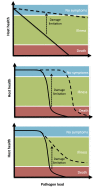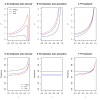Limiting damage during infection: lessons from infection tolerance for novel therapeutics
- PMID: 24465177
- PMCID: PMC3897360
- DOI: 10.1371/journal.pbio.1001769
Limiting damage during infection: lessons from infection tolerance for novel therapeutics
Abstract
The distinction between pathogen elimination and damage limitation during infection is beginning to change perspectives on infectious disease control, and has recently led to the development of novel therapies that focus on reducing the illness caused by pathogens (‘‘damage limitation’’)rather than reducing pathogen burdens directly (‘‘pathogen elimination’’). While beneficial at the individual host level, the population consequences of these interventions remain unclear. To address this issue,we present a simple conceptual framework for damage limitation during infection that distinguishes between therapies that are either host-centric (pro-tolerance) or pathogen-centric (anti-virulence). We then draw on recent developments from the evolutionary ecology of disease tolerance to highlight some potential epidemiological and evolutionary responses of pathogens to medical interventions that target the symptoms of infection. Just as pathogens are known to evolve in response to antimicrobial and vaccination therapies, we caution that claims of ‘‘evolution-proof’’ anti-virulence interventions may be premature, and further, that in infections where virulence and transmission are linked, reducing illness without reducing pathogen burden could have non-trivial epidemiological and evolutionary consequences that require careful examination.
Conflict of interest statement
The authors have declared that no competing interests exist.
Figures




References
Publication types
MeSH terms
Substances
Grants and funding
LinkOut - more resources
Full Text Sources
Other Literature Sources
Medical

